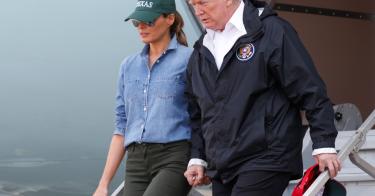With Hurricane Harvey leaving massive amounts of damage in its wake and Hurricane Irma now heading toward Florida, tools for disaster management, response, and recovery are needed more than ever.
Looking to past examples, one model that may serve the Trump administration well is to set up a temporary commission to handle a disaster, as detailed in the book “Mismanaging Mayhem” by Richard Weitz and Jim Carafano, vice president for foreign policy and national security at The Heritage Foundation.
This model was put into practice in 1964 when, on Good Friday, the most powerful earthquake ever recorded in North America struck Alaska. President Lyndon Johnson created a temporary commission to oversee the recovery in Alaska, made up of Cabinet officials from the Departments of Defense to Interior to Labor.
The commission was small, and headed by a high-level career government official—in this case, the number 3 official at the Atomic Energy Commission—who managed the commission’s day-to-day operations. The small staff was comprised of personnel from the various agencies involved in the commission.
One of Johnson’s notable moves was to appoint Sen. Clinton Anderson, D-N.M., a political ally with previous executive experience, to chair the commission. This did several things:
- It helped take the strain off the various agencies that were doing the legwork during the recovery. The commission coordinated the various agency efforts, but did not usurp their unique authority.
- With the executive director running day-to-day operations, the chairman was freed up to handle larger policy problems. Empowered by the president and working within a Cabinet-level commission, key decisions could be made quickly and innovative solutions applied.
The chairman could also act as the visible head of the recovery effort, working with governors and mayors to allay their concerns and those of their constituents.
- It moved the politics of disaster relief out of the White House. Disasters involve many factors, including political ones. The White House needs to be viewed as active in the recovery effort, but president also can’t give it his undivided attention due to the countless other issues facing him.
A trusted commission, chaired by a trusted ally, allows the administration to remain fully engaged in the recovery effort.
This model from 1964 would no doubt need a facelift if applied in today’s government, but the concept remains the same. A high-ranking career official would be the executive director, and relevant Cabinet or sub-Cabinet officials could be tapped to participate in the commission.
As for the chairman, he or she should be someone who is influential and respected, has knowledge of the area or disaster relief, can be politically trusted by the White House, and has some executive experience.
With Harvey having inflicted tens of billions of dollars in damage to Texas, and with Hurricane Irma reaching record-breaking strength on its path toward Florida, the Trump administration will need all the disaster relief and recovery help it can get.
A Cabinet-level commission is one idea to be considered.
This piece originally appeared in The Daily Signal


